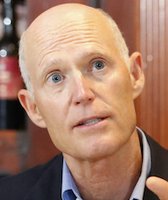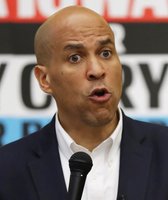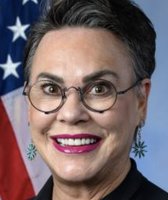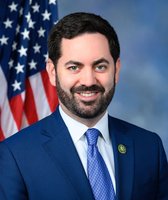Stand up for the facts!
Our only agenda is to publish the truth so you can be an informed participant in democracy.
We need your help.
I would like to contribute
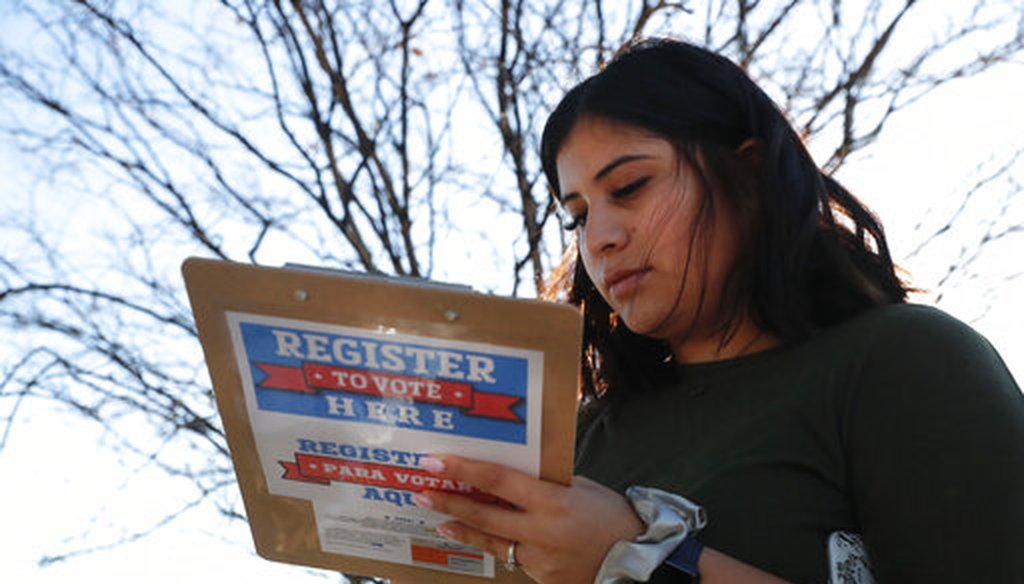
Karina Shumate, 21, a college student studying stenography, fills out a voter registration form in Richardson, Texas, on Jan. 18, 2020. (AP)
If Your Time is short
• Experts say voter turnout is likely to be high in the 2020 general election, citing high levels of engagement on both the Democratic and Republican sides.
• Bernie Sanders is basing his strategy on his ability to increase turnout among young, first-time voters.
• But historically, young voters have turned out at lower rates than other age groups, and that pattern has continued in this year’s primary contests.
Bernie Sanders has staked his presidential candidacy on expanding voter turnout.
"The key to this election is, can we get millions of young people who have never voted before into the political process — many working people who understand that Trump is a fraud — can we get them voting?" Sanders told the Los Angeles Times. "That is the key to this election."
How hard a task would it be to expand voter turnout — for Sanders or any Democratic nominee? And how hard will it be to increase youth turnout specifically? We questioned experts and looked at the data, including results from the Super Tuesday primaries.
We found that voter turnout is expected to be high in the 2020 general election, though it’s unclear whether the type of mass mobilization of young voters sought by Sanders will materialize, even if he ends up as the Democratic nominee. (The Sanders campaign did not respond to an inquiry for this article.)
Voter turnout in the U.S. is low compared with other countries
In his speech after the South Carolina primary concluded, Sanders noted that the U.S. has "the lowest voter turnout of almost any major country on Earth." That’s essentially correct.
Sign up for PolitiFact texts
According to the Pew Research Center, the U.S. voter turnout rate trails those of most of the countries in the Organization for Economic Cooperation and Development, which includes the major industrialized democracies. The U.S. ranked 26th in voter turnout of the 32 countries for which comparisons could be made.
The two charts below show that since the 1960s, turnout rates have hovered between 51% and 62% in U.S. presidential elections, and between 37% and 50% in midterm elections. These percentages are drawn from research by University of Florida political scientist Michael McDonald and his U.S. Elections Project, and use the number of Americans eligible to vote, rather than those who are of voting age, as the denominator.
Could overall turnout in the 2020 general election be unusually high?
Most experts we contacted agreed that this fall’s turnout levels have a good shot at being higher than usual. That’s partly extrapolated from a 2018 midterm turnout rate that was the highest since 1914, and unusually high levels of turnout in various special elections for Congress and other offices.
"I expect 2020 voter turnout to be exceptional, perhaps the highest in over a century, since 1908," McDonald said. "I sometimes refer to it as ‘the storm of the century.’ Respondents to surveys already report interest in voting running at October levels. Consumption of political news is up, and small-donor activity is up, among many other factors."
Barry Burden, a University of Wisconsin political scientist, is one of many experts who cite the presidency of Donald Trump as the reason for a high level of engagement — on both sides.
"Democrats are clearly upset by Trump's actions in office and dismayed that they lost the 2016 electoral vote," Burden said. "But Republican voters also made a strong showing in 2018 and will be activated again this year, in part because of the vindication that the impeachment acquittal provided."
Indeed, in several states, Trump has racked up large numbers of votes even in the essentially non-competitive Republican primaries that have been held so far. We compared the number of votes won by Trump with the number of votes won by President Barack Obama in 2012 — an analogous election in which the incumbent president faced no significant competition.
Trump exceeded Obama’s 2012 primary vote totals not only in such red states as Alabama, Arkansas, Oklahoma, Tennessee and Texas, but also in such purple or blue states as New Hampshire and Massachusetts. Trump fell short of Obama’s 2012 totals in just two states so far: North Carolina and Sanders’ home state of Vermont.
Youth turnout tends to be lowest of any age group
One of the most consistent patterns seen in voter turnout is that young voters go to the polls at lower rates than other age groups do.
Here’s a turnout breakdown for four different age groups — 18 to 29, 30 to 44, 45-59, and 60-plus. The lines always zigzag up for presidential elections and down for midterm elections, but the pattern is consistent in either type of election: The youngest group always has the lowest turnout rate, and the oldest group always has the highest.
Young voters also consistently make up the smallest share of all voters when looking at those four age groups, as shown in this chart.
The problems are primarily structural, said John Holbein, a public policy professor at the University of Virginia’s Frank Batten School of Leadership and Public Policy and author of the book "Making Young Voters: Converting Civic Attitudes into Civic Action."
"Young people fail to vote because of structural issues with how elections are run and how poorly civics education is taught in America," he said.
That said, the 2018 youth vote was at its highest level and share in a midterm in decades — a possible indicator of continued growth in 2020.
"The Sanders’ campaign has clearly galvanized the youth vote in ways that are focused explicitly on movement building," said Elizabeth Bishop, who tracks political activity among young people for the City University of New York’s Youth Studies Program. "His campaign has worked with local organizers across the country and built coalitions" with such youth-led movements as the Sunrise Movement, a climate-change group, and Black Lives Matter.
Yet some research suggests that Sanders — even if he’s the nominee — would have difficulty helping the Democratic cause on balance.
A recent paper by David Broockman of the University of California-Berkeley and Joshua Kalla of Yale University concluded that Sanders as the nominee would lose some swing voters compared with a generic Democrat. To counteract this, they concluded, Sanders would have to boost youth turnout by about 11 percentage points — from 37% turnout among those under 35 in 2016 to 48% in 2020. That’s about double the boost seen among black voters when Obama first ran in 2008.
What have the early 2020 Democratic primaries suggested about youth turnout?
So far, indicators from the 2020 primaries and caucuses do not suggest a youth turnout boom — at least not one that’s been bigger for youth than it has been for voters overall.
Even in the earliest contests — when Sanders was faring well overall and especially well with younger voters — there was little evidence of a boom in turnout for Sanders, or among youth more generally.
In Iowa, a New York Times analysis found that turnout increases were concentrated in more well-educated areas where Sanders struggled, rather than in areas where he ran strongly. As for the New Hampshire primary, David Wasserman, an analyst with the Cook Political Report, calculated that Democratic turnout rose beyond 2016 levels by 26.5% in towns won by Pete Buttigieg, by 25.2% in towns won by Amy Klobuchar, and by just 12% in towns won by Sanders.
And in the South Carolina primary, a Washington Post analysis found that the most pronounced increases came in precincts that had the most registered voters over 64 years old. In those precincts, turnout almost doubled, although turnout also rose across younger precincts.
McDonald said the evidence suggests that Sanders is not "delivering the turnout revolution he promises."
The early indications from the Super Tuesday states back up this assessment. In fact, youth turnout fell as a share of all voters in every state for which there is comparable exit poll data for 2016 and 2020.
This chart shows that eight of 14 Super Tuesday states where there’s comparable data for 2016 and 2020 saw a decline in the share of voters who were in the 18-to-29 age group.
This doesn’t mean that the absolute number of young voters fell in each of these states; it may well have increased. Rather, this data shows that any rise in youth turnout was outpaced by an even faster rise in turnout by other age groups.
Bishop said that such results "clearly speak to the need for continued efforts to get out the vote across all age groups, including the youth vote."
Holdbein added that the election is still months away, and things could change.
"Talk is cheap, and many of the people who say they plan on voting in 2020 will fail to do so," Holbein said. "The problem with young people is not that they lack political interest. It's that they have trouble following through on their high levels of political interest and actually show up at the ballot box. So, high levels of political interest among young people can only tell us so much."
Our Sources
Los Angeles Times, "Q&A: Bernie Sanders says Trump will be hard to beat, but he knows how to do it," Dec. 26, 2019
Bernie Sanders, remarks after the South Carolina primary, Feb. 29, 2020
New York Times, "Live Analysis: Super Tuesday," accessed March 4, 2020
U.S. Elections Project, main voter turnout page, accessed March 3, 2020
Washington Post, "Exit polls from the 2020 Democratic Super Tuesday contests," March 4, 2020
CNN, 2016 primary exit polls, accessed March 4, 2020
Pew Research Center, "U.S. trails most developed countries in voter turnout," May 21, 2018
Washington Post, "Turnout in South Carolina makes Biden’s win even more impressive," March 2, 2020
New York Times, "Sanders Says He’ll Attract a Wave of New Voters. It Hasn’t Happened," Feb. 24, 2020
David E. Broockman and Joshua L. Kalla, "Candidate Ideology and Vote Choice in the 2020 US Presidential Election" (working paper), Feb. 25, 2020
Vox.com, "Bernie Sanders looks electable in surveys — but it could be a mirage," Feb. 25, 2020
Andrew B. Hall and Daniel M. Thompson, "Who Punishes Extremist Nominees? Candidate Ideology and Turning Out the Base in US Elections," 2018
David Wasserman, tweet, Feb. 12, 2020
Center for Information and Research on Civic Learning & Engagement, live blog for Super Tuesday, accessed March 4, 2020
Rolling Stone, "Inside Bernie Sanders’ Plan for a Youth Vote Revolution," March 3, 2020
Rolling Stone, "Democrats Have a Turnout Problem," March 2, 2020
Michelle Goldberg, "Bernie Sanders Can’t Count on New Voters" (New York Times column), March 2, 2020
New York magazine, "Could a Youth-Vote Surge Offset Bernie’s Vulnerabilities in November?" Feb. 25, 2020
U.S. News and World Report, "Preparing for a Voter Surge," Sept. 20, 2019
Email interview with Jan Leighley, professor of government at American University, March 3, 2020
Email interview with David Broockman, University of California-Berkeley political scientist, March 3, 2020
Email interview with Elizabeth Bishop, City University of New York’s Youth Studies Program, March 3, 2020
Email interview with Barry Burden, University of Wisconsin political scientist, March 3, 2020
Email interview with Michael McDonald, University of Florida political scientist, March 3, 2020
Email interview with John Holbein, public policy professor at the University of Virginia’s Frank Batten School of Leadership and Public Policy and author of "Making Young Voters: Converting Civic Attitudes into Civic Action," March 4, 2020
Email interview with Jake Neiheisel, political scientist at the University of Buffalo, March 4, 2020






